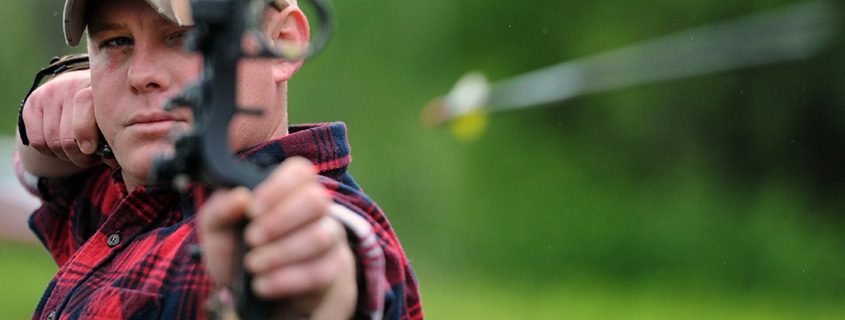Two Injury-Prone Areas Bow Hunters Should Scout For
Article Featured on OSMSGB
If you think about the basic actions of shooting a bow – pull back with the fingers and arm, rotate through the shoulder, hold, and release – it probably becomes clear why upper extremity conditions are some of the most commonly diagnosed injuries among bow hunters. The drawing back of the strings demands a lot from the smaller muscles of the rotator cuff, forearm, wrist, and fingers. Plus, repetitive target practice to improve aim, timing, and other hunting skills can easily result in chronic pain or injury from overuse.
Let’s take a look at two commonly injured areas in bow hunters.
- The Rotator Cuff
The rotator cuff is made up of muscles and tendons that cover the top of the upper arm bone and attach to the shoulder blade, keeping the arm in the shoulder socket. It is a common source of shoulder pain, especially in bow hunters or people who perform a lot of overhead lifting, pulling, or rotating of the shoulder.
Three common sources of rotator cuff pain include:
- Tendonitis: The rotator cuff tendons become irritated or damaged.
- Bursitis: The fluid-filled “pillow” that acts a cushion between the rotator cuff and shoulder blade becomes irritated or inflamed.
- Tears: Damage to the rotator cuff that results in significant pain and weakness. Tears can be caused by an acute injury, or the symptoms may gradually progress over time due to overuse.
Tendonitis, bursitis, and minor or partial rotator cuff tears can all typically be resolved non-surgically through the use of anti-inflammatory medications, rest, strengthening exercises, and possible injections.
A complete tear of the rotator cuff, or a partial tear that doesn’t respond to conservative treatment, will most likely require surgery. The procedure will reattach the torn tendon to the upper arm bone and help restore function.
There are two main options for surgically repairing rotator cuff tears: arthroscopic and mini-open repairs. While each of the methods available has its own advantages and disadvantages, both have the same goal – getting the tendon to heal. The type of repair performed depends on several factors, including the size of your tear, your anatomy, and the quality of the tendon tissue and bone.
- Arthroscopic Repair
During arthroscopy, a small camera called an arthroscope is inserted into your shoulder joint. The camera displays pictures on a television screen that the surgeon uses to guide miniature surgical instruments. Because the scope and surgical instruments are thin, very small incisions (cuts) can typically be used, rather than the larger incision needed for standard, open surgery.
- Mini-Open Repair
Some surgeons will perform a mini-open repair through a small incision. The incision is typically 3 to 5 cm long. The surgeon repairs the rotator cuff through the mini-open incision. During the tendon repair, the surgeon views the shoulder structures directly, rather than through the video monitor.
A full recovery after either procedure will take several months, but the majority of patients report improved shoulder strength, decreased pain, and most are able to return to the activities they enjoyed before their injury.
One of the best ways to prevent these and other chronic shoulder conditions is through proper strength and conditioning of the shoulders. Check out the American Academy of Orthopaedic Surgeon’s Rotator Cuff and Shoulder Conditioning Program.
- The Forearm
Since bow hunters rely on the muscles, tendons, and nerves that run through the forearm and into the fingers to draw their bows back and accurately release them, this area of the upper body is easily susceptible to overuse injuries.
One type of overuse injury in the forearm is medial epicondylitis.
This condition results in inflammation of the tendons that attach the forearm muscles to the elbow. Two ways to help prevent this are:
- Proper rest time in between target practicing and hunting trips to allow the overused tendons to repair.
- Strengthening the forearm muscles.
Bow hunters might also experience median nerve compression in the wrist or elbow. The median nerve is one of three main nerves that run from the neck all the way into the hand. When this nerve becomes compressed as it travels through the elbow or wrist, it can cause pain, weakness, numbness, and tingling. Typically, symptoms are felt in the hands.
These forearm conditions can oftentimes be treated through non-surgical methods such as splinting, anti-inflammatory medications, rest, and activity modification.
“The goal of any treatment plan is to relieve symptoms and restore function in the long-term so that patients can get back to the activities they enjoy,” says Dr. Ben Zellner, orthopedic hand-to-shoulder surgeon at OSMS. “Therefore, if symptoms stop responding to treatments or quality of life is significantly affected by pain and limited function, surgical options may become the best solution.”
Orthopedic & Sports Medicine Center of Oregon is an award-winning, board-certified orthopedic group located in downtown Portland Oregon. We utilize both surgical and nonsurgical means to treat musculoskeletal trauma, spine diseases, sports injuries, degenerative diseases, infections, tumors and congenital disorders.
Our mission is to return our patients back to pain-free mobility and full strength as quickly and painlessly as possible using both surgical and non-surgical orthopedic procedures.
Our expert physicians provide leading-edge, comprehensive care in the diagnosis and treatment of orthopedic conditions, including total joint replacement and sports medicine. We apply the latest state-of-the-art techniques in order to return our patients to their active lifestyle.
If you’re looking for compassionate, expert orthopedic surgeons in Portland Oregon, contact OSM today.
Phone:
503-224-8399
Address
1515 NW 18th Ave, 3rd Floor
Portland, OR 97209
Hours
Monday–Friday
8:00am – 4:30pm



